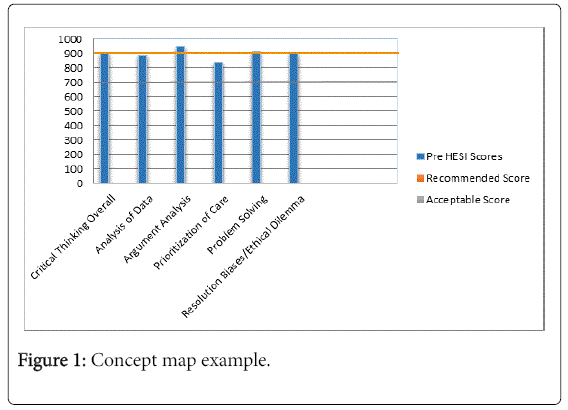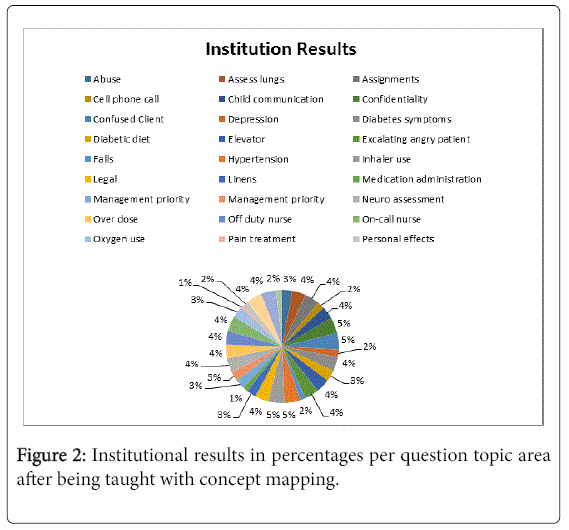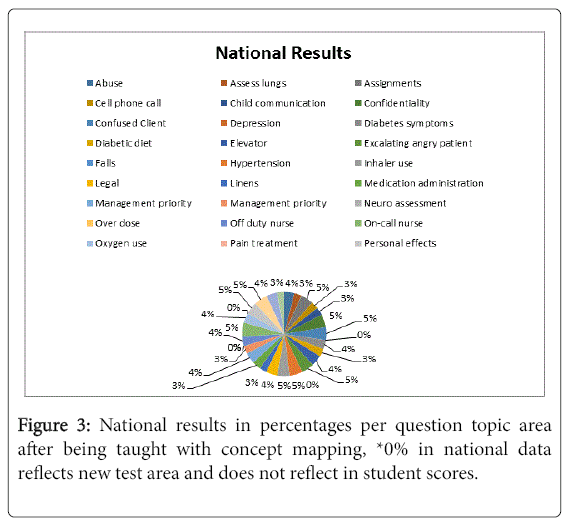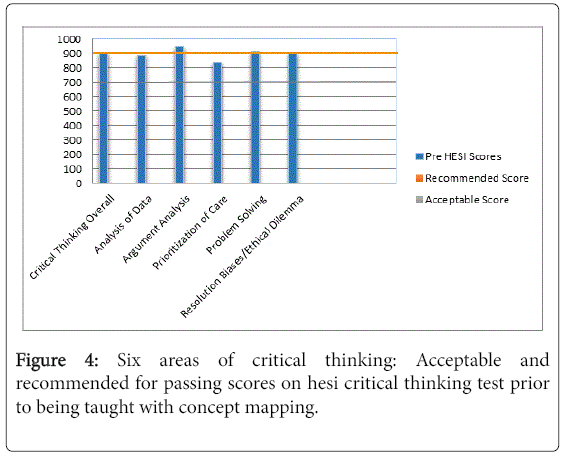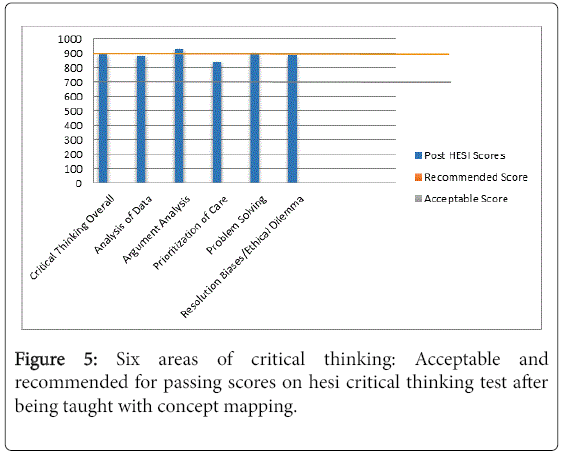Research Article Open Access
Teaching Students Concept Mapping to Enhance Critical Thinking in a Mental Health Nursing Course
Janet Garwood* and Amy HammoudCollege of Nursing, Purdue University Northwest, USA
- Corresponding Author:
- Janet Garwood
Assistant Professor
College of Nursing, Purdue University Northwest, USA
Tel: 2197855281
E-mail: jgarwo07@pnw.edu
Received date: June 16, 2017; Accepted date: July 10, 2017; Published date: July 17, 2017
Citation: Garwood J, Hammoud A (2017) Teaching Students Concept Mapping to Enhance Critical Thinking in a Mental Health Nursing Course. J Comm Pub Health Nurs 3:186. doi:10.4172/2471-9846.1000186
Copyright: © 2017 Garwood J, et al. This is an open-access article distributed under the terms of the Creative Commons Attribution License, which permits unrestricted use, distribution and reproduction in any medium, provided the original author and source are credited.
Visit for more related articles at Journal of Community & Public Health Nursing
Abstract
Aim: The purpose of this study was to explore the level of critical thinking of millennial nursing students enrolled in a mental health nursing course by using a constructivist approach and utilizing concept mapping as a teaching and learning tool.
Background: Nursing education should keep in pace with the advances in technology and changes in healthcare. Faculty should consider the diverse learning needs of their students when planning courses and clinical experiences. As evidence-based practice guides health care, so should it guide nursing educators when selecting teaching and learning activities. Educators might be wise to consider strategies which are proven to adequately prepare students to be safe and effective entry-level nurses.
Method: Critical thinking of students will be measured using a pre and post-HESI specialty exam, which is designed to measure the critical thinking ability of students.
Results of learning outcomes: The students exceeded the national average in 23/30 (73%) in 30 categories of critical thinking and achieved acceptable or recommended levels in 5/5 areas of critical thinking in an HESI Critical Thinking exam.
Conclusion: The outcome of the HESI critical thinking exams demonstrated that students were successful developing critical thinking, synthesis of data to guide clinical decisions and demonstrate contextualized judgment and reasoning.
Keywords
Concept maps; Critical thinking; Nursing education; Millennial students
Introduction
The National League for Nursing (NLN) states that nursing education should keep in pace with the Advances in technology and changes in healthcare [1]. Millennial is a term which describes many nursing students enrolled in today’s nursing programs as many of these students were born between the years 1980-2004 [2]. Garwood [3] discovered that these students have distinctly different preferences for learning and faculty should consider the diverse learning needs of their students when planning lesson plans and clinical activities. As evidence-based practice guides health care, so should it guide nursing educators when selecting teaching and learning activities. Educators might be wise to consider strategies which are proven to adequately prepare students to be safe and effective entry-level nurses. The National League for Nursing [1], identifies “Translation of research outcomes into evidence-informed educational practices” (p. 2), as a research priority for nurse educators. The purpose of this study was to explore the level of critical thinking of nursing students enrolled in a mental health nursing course by utilizing concept mapping as a teaching and learning tool. Student learning outcomes and the critical thinking skills of students will be measured using a pre and post-HESI specialty exam, which is designed to measure the critical thinking ability of students.
Literature Review
Concept mapping was first identified by Novak in 1972 while teaching at Cornell University. Novak and Gowin continued this research and eventually published a book titled “Learning How to Learn” [2]. Clayton [4] summarized much of the research that was performed from 1994-2005 and concluded that the use of concept maps had a positive impact on academic performance and critical thinking abilities. Harrison and Gibbons [5] suggest a further investigation by creating research designs which employ a longitudinal approach since critical thinking is a skill that may require time to develop. Some researchers conclude that concept mapping can be an effective method for students with a variety of learning preferences, as individual learning styles might be considered when selecting strategies to enhance learning outcomes. Hink et al. [6] suggest that concept maps can move students from rote memorization to a higher level of comprehension and can facilitate the application of knowledge and skills when caring for clients with complex health needs. Abel and Freeze [7] suggests to further explore and identify best practice for effective implementation of concept mapping as a primary teaching strategy in nursing education. The need for further studies to evaluate the impact on critical thinking was identified by Khan et al. [8].
Framework
This study occurred in a classroom designed using a constructivism approach [9] by providing learning activities centered on group learning. Students were taught how to develop and use a concept map at the beginning of the course by the professor.
Lesson plans included group work creating concept maps (Appendix A and Figure 1) and unfolding case studies which required learners to create additional knowledge by linking and drawing upon previously acquired data and facts. This approach allows students to apply their learning which stimulates comprehension and long-term memory, which is critical for nursing students as they progress through the six levels of cognitive domain (remembering, understanding, applying, analyzing, evaluating and creating).
Research Objective and Question
Can using concept maps both as a method for delivering course content and for group activities enhance critical thinking skills and achieve learning outcomes?
Population and sample
The study originated on the campus of a University in the Midwest in Spring 2016 with a population size of N=5841 students. The students were recruited from a four-year, baccalaureate nursing degree program. A convenience sample (n=35) was used to recruit students, as the instructional strategies that were employed were standard in the course pedagogy. The course in which the study occurred was mental health, psychosocial nursing course and students enrolled in this course were in their fifth semester of nursing school.
Methods
Using this constructivist approach, the authors utilized concept maps and group work to encourage students to learn from each other and key concepts presented in the classroom. Concept maps were created by the lecturer to facilitate understanding of course topics and key concepts and as a method to instruct students on the method to create concept maps. Case studies that mirror the real-world scenarios that are developed by the instructors are then assigned to individual student groups. The nursing process of assessment, diagnosis, planning and identified goals of treatment were included in each concept map. Such topics include, but are not limited to, bipolar and related disorders, depressive disorders, suicide, self-injury and anger/ aggression. Implementation of the chosen interventions includes pharmacological administration as well as topics which are appropriate for client teaching. All students are instructed to continue to evaluate the interventions to determine the efficacy and for potential adverse effects. In a final step of creating this concept map, students are encouraged to make links and formulate potential multiple choice questions which can construct further knowledge and develop reflection of the chosen interventions. As students are creating the concept maps and drawing on their ‘real-life’ experiences from the clinical setting and prior nursing courses, the faculty interacts with students to offer additional support and guidance.
Instruments and measurement
The instrument used in the study is a critical thinking specialty exam delivered by the instructors and scored by Health Education Systems Incorporated (HESI). This test is a 25 question specialty exam which evaluates critical thinking. The authors used the HESI exam to ensure validity and reliability. The university was already using HESI to test students thus this testing protocol was familiar to the students.
The study design used a pre and a post-test to determine if teaching through concept maps can engage students and enhance critical thinking. Students answer questions within five categories which include problem solving, biases and ethical dilemmas, argument analysis and analysis of data. All items include a rationale for each test item that is written at a higher cognitive level, require multi-logical thinking and has only one correct answer with multiple plausible alternatives.
The HESI test is scored using a Likert-type system where all answers are correct, but students are asked to choose the best answer from the ones provided. Each answer receives a score ranging from 0-1000. Students receive the maximum weight for choices that require a higher level of critical thinking and students will receive the minimum weight for decisions requiring the least critical thinking, furthermore, the higher the student score, the better critical thinking skills the student possesses. The questions presented to each student simulate a healthoriented scenario with various responses leaving students to choose the most appropriate answer. Correct answers are associated with a higher level of analysis urging the student to use critical thinking to answer each question. Reliability of HESI examinations is determined by performing an item analysis on the aggregated data and reported using a point biserial correlation coefficient for accuracy within the 0.87-0.99 percentile range. Elsevier end-of-program testing and exit exams range in the highest categories for estimated reliability coefficients using the Kuder-Richardson Formula 20 (KR-20) and range from 0.90 to 0.94. Students are tested with a pre and post-test in the classroom on line through the Elsevier (Evolve) web based testing site. Each test is scored by the Evolve Company and a report of the results was sent to the instructor of the course. These tests were used to asses for development of critical thinking.
Data collection
This study was determined to be exempt and was approved by the University Institutional Review Board (IRB). Students were provided an overview and purpose of the study and were instructed that participation was voluntary. The students were encouraged to ask any questions and were assured confidentiality of data. Students were also provided the option to decline participation or opt out of the study at any time. The study data that was collected consisted of a brief demographic survey and a pre and post-HESI critical thinking exam that was taken electronically in the classroom setting. All questions asked within the test are property of Elsevier and are scored by the company and a report form was received by the instructor.
Data analysis
32/35 (n=32/35) or 91% students volunteered to participate in the study. No students dropped out of the study or withdrew from the course during the semester. The majority 69% (n=22/32) of the students were between the ages of 18-26. More than 59% of the students reported having experience working in a healthcare setting. When asked about employment, 31% (n=10) stated that they were not employed while attending school. Students who reported working part time 56% (n=18) and students reporting full time employment 13% (n=4). The prior use of concept maps was evaluated and n=19/32 students reported no prior experience in making or using concept maps in nursing school. When asked “Do you find concept maps challenge you to think?” 84%, (n=27/32) students reported ‘yes’. The students self- reported an estimate of their grade point average was 3.15/4/0. The majority or 72% (n=23/32) of the students indicated that they were full-time students currently enrolled in at least 12 credit hours.
Results of Learning Outcomes
The students exceeded the national average in 23/30 (73%) in 30 categories of critical thinking (Appendix A and Figures 2 and 3) and achieved acceptable or recommended levels in 5/5 areas of critical thinking (Appendix A and Figures 4 and 5) in an HESI Critical Thinking exam. The pre and post-HESI critical thinking exam failed to demonstrate a significant difference between the exam scores; student’s verbalized preference of concept mapping as a teaching tool over standard lecture of Power-Point slides. Continued use of concept mapping as a teaching tool with further testing would yield better impact scores.
Limitations
Convenience sampling was identified as a constraint within this study and the authors suggest further research utilizing randomized samples in a variety of settings. It is also important to note that critical thinking skills may take time to develop and the authors and other literature suggest longitudinal studies which evaluate the development of critical thinking skills over an extended period or several semesters. Further studies which utilize larger, randomized samples are recommended to ensure the results could represent larger populations are also recommended.
Furthermore with a larger student sample two sections of the course could be taught one using traditional teaching methods and one taught through concept mapping. This would yield results that may be helpful in determining if concept mapping helps to improve critical thinking.
Conclusion
Concept mapping can be viewed as a constructivism approach to learning by providing learners to link additional knowledge to previously acquired learning. Creating concept maps in a group learning environment allows students to develop self-awareness and reflect on relevant concepts, rather than rote memorization of irrelevant data. This learning environment was conducive in stimulating both cognitive and affective domains of learning. Despite failure to demonstrate a significant difference between the exam scores to the outcome of the HESI critical thinking exams; students demonstrated success in developing critical thinking, synthesis of data to guide clinical decisions and show contextualized judgment and reasoning within classroom work and group study. Providing students with opportunities for reflections and create multiple choice questions also added value to the lesson plan.
In this study, the authors participated in the inquiry process which further disseminates results of scholarly activities which can be used to further develop the science of nursing education. This research explored scholarly activities which utilized evidence-based resources proven to improve and support teaching strategies which resulted in achieving the student learning outcomes of the course. This study aligns with the NLN’s ultimate goal of the nursing educator is to prepare students to be practitioners who provide exceptional healthcare.
References
- National League of Nursing (2016) NLN Nursing research priortities in nursing education 2016-2016.
- Novak J, Gowin D (1984) Learning how to learn. New York: Cambridge University Press.
- Garwood JK (2015) Millennial students' preferred methods for learning concepts in psychiatric nursing. J Psychosoc Nurs Ment Health Serv 53: 38-43.
- Clayton LH (2006) Concept mapping: An effective, active teaching-learning method. Nurs Educ Perspect 27: 197-203.
- Harrison S, Gibbons C (2013) Nursing student perceptions of concept maps; From theory to practice. Research Journal of the National League of Nursing 34: 395-399.
- Hink SM, Webb P, Sims-Giddens S, Helton C, Hope KL, et al. (2006) Student learning with concept mapping of care plans in community-based education. J Prof Nurs 22: 23-29.
- Abel WM, Freeze M (2006) Evaluation of concept mapping in an associate degree nursing program. J Nurs Educ 45: 356-364.
- Khan B, Ali F, Barolia R, Rehan S (2011) Students’ perceptions of clinical teaching and learning strategies: a Pakistani perspective. Nurse Educ Today 32: 85-90.
- Vygotsky LS (1980) Mind in society: The development of higher psychological processes. Harvard university press.
Relevant Topics
- Chronic Disease Management
- Community Based Nursing
- Community Health Assessment
- Community Health Nursing Care
- Community Nursing
- Community Nursing Care
- Community Nursing Diagnosis
- Community Nursing Intervention
- Core Functions Of Public Health Nursing
- Epidemiology
- Epidemiology in community nursing
- Health education
- Health Equity
- Health Promotion
- History Of Public Health Nursing
- Nursing Public Health
- Public Health Nursing
- Risk Factors And Burnout And Public Health Nursing
- Risk Factors and Burnout and Public Health Nursing
Recommended Journals
- Epidemiology journal
- Global Journal of Nursing & Forensic Studies
- Global Nursing & Forensic Studies Journal
- global journal of nursing & forensic studies
- journal of community medicine& health education
- journal of community medicine& health education
- Palliative Care & Medicine journal
- journal of pregnancy and child health
Article Tools
Article Usage
- Total views: 8959
- [From(publication date):
August-2017 - Nov 23, 2024] - Breakdown by view type
- HTML page views : 8196
- PDF downloads : 763

